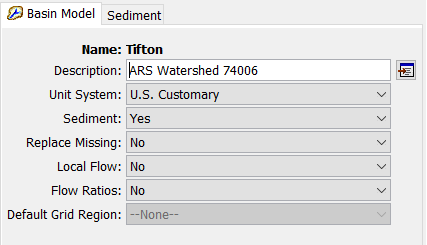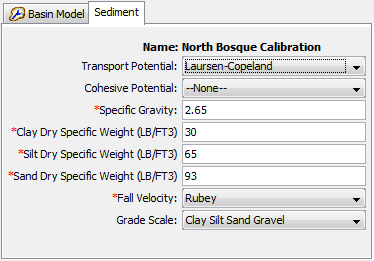Download PDF
Download page Watershed Sediment Properties.
Watershed Sediment Properties
Erosion and sediment transport are optional components in the basin model. By default, the component features are deactivated, data entry tools for sediment are not visible in the program interface, and no sediment results are computed during a simulation. The features become accessible when they are activated for the basin model. Activate the features on the Component Editor for the basin model (Figure 1). Access the Component Editor by clicking the basin model icon on the "Components" tab of the Watershed Explorer. Use the selection list to switch between activating and deactivating the sediment features. When the features are turned on, you must make selections and enter parameter data at each element (subbasin, reach, reservoir, source, and diversion) in the basin model. When the features are deactivated, all parameter data for the sediment methods are deleted from the basin model and its elements. Once the sediment components have been deactivated, it is not possible to recover the deleted settings or parameter values.

Figure 1. Activating the erosion and sediment transport features in the basin model.
Erosion and sediment transport modeling requires a number of properties to be specified. These global properties are applied to all elements in the basin model. The properties are presented on a separate Component Editor from the basin model editor. The "Sediment" editor is always shown next to the "Basin Model" editor (Figure 2).

Figure 2. Selecting important sediment methods and entering parameter data that will be applied to all elements within the basin model..
The transport potential method specifies how the sediment carrying capacity of the stream flow will be calculated for non-cohesive sediments. Many methods have been proposed for calculating the transport potential. Each method is developed for a particular sediment grain-size distribution and environmental conditions. The same transport potential method will be used at all reaches within the basin model. The available choices are shown in the table below. A cohesive transport potential method can also be selected. When selected, transport of cohesive sediment is computed in addition to the non-cohesive sediment.
Transport potential functions for calculating the amount of sediment that can be carried by the stream flow. Type is non-cohesive (NC) or cohesive (CO). Method is excess shear (ES), stream power (SP), or regression (RE).
Method | Type | Method | Reference |
Ackers-White | NC | SP | Ackers and White, 1973 |
Engelund-Hansen | NC | SP | Engelund and Hansen, 1967 |
Laursen-Copeland | NC | ES | Laursen, 1958; Copeland and Thomas, 1989 |
Meyer-Peter Muller | NC | ES | Meyer-Peter and Müller, 1948 |
Toffaleti | NC | RE | Toffaleti, 1968 |
Wilcock | NC | ES | Wilcock and Crowe, 2003 |
Yang | NC | SP | Yang, 1984 |
Krone Parthenaides | CO | ̶ | Krone, 1962; Parthenaides, 1962 |
The specific gravity of the sediment grains must be specified. The default value of 2.65 is provided. The default value may be changed if a different value is more appropriate in your watershed.
The density of dry clay sediment must be specified as appropriate for the selected unit system. The default dry density is 481 kg/m3 while the default dry specific weight is 30 lb/ft3. The same density is used for all size subclasses of clay.
The density of dry silt sediment must be specified with the same density used for all size subclasses. The default dry density is 1,041 kg/m3 while the default dry specific weight is 65 lb/ft3.
The density of dry sand, gravel, cobble, and boulder sediments must be specified. The same density is used for all size subclasses from very fine sand to boulders. The default dry density is 1,490 kg/m3 while the default dry specific weight is 93 lb/ft3.
Some of the available transport potential methods require the calculation of fall velocity. Fall velocity is also used in several of the sediment settling methods for the reservoir element. All reaches and reservoirs that require the calculation of a fall velocity will use the method selected in the sediment properties. The available methods for calculating fall velocity include Report 12 (Interagency Committee, 1957), Rubey (1933), Toffaleti (1968), and Van Rijn (1993). The default selection is Rubey.
Two different grade scale systems are available. The selected system will determine the number of grain sizes used for calculating erosion and sediment transport throughout the basin model. Calculations of erosion, deposition, settling, and transport are carried out separately and independently for each size in the selected grade scale. The Clay Silt Sand Gravel system only recognizes four broad size classifications. The AGU 20 system recognizes 20 different size classifications, generally breaking each of the four broad size classifications into sub-classifications.